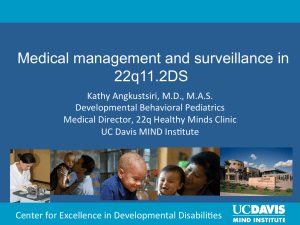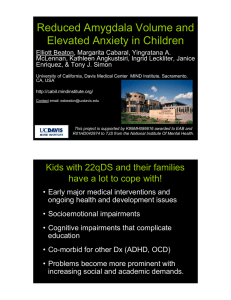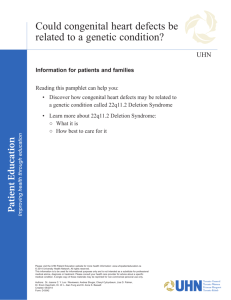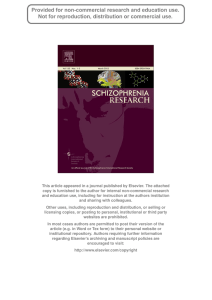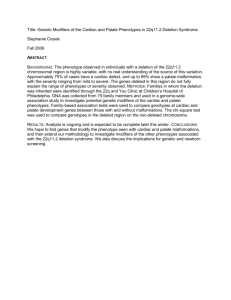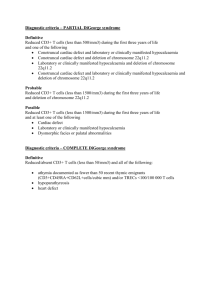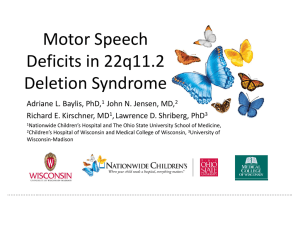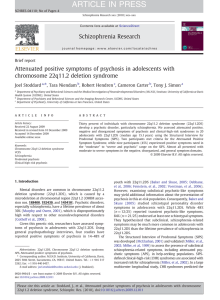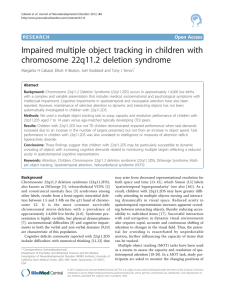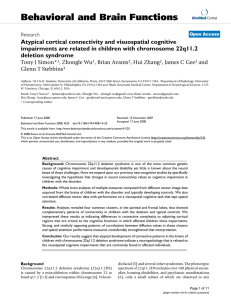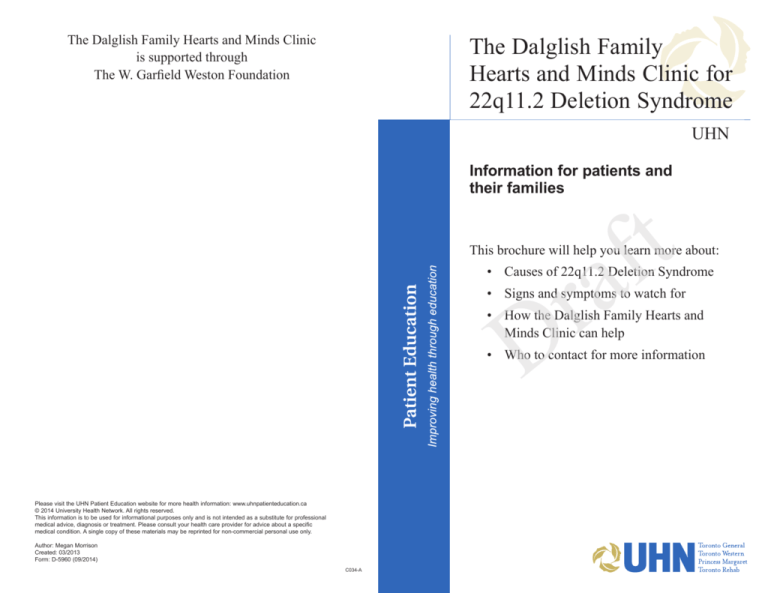
The Dalglish Family Hearts and Minds Clinic
is supported through
The W. Garfield Weston Foundation
The Dalglish Family
Hearts and Minds Clinic for
22q11.2 Deletion Syndrome
UHN
Information for patients and
their families
t
f
a
r
D
This brochure will help you learn more about:
• Causes of 22q11.2 Deletion Syndrome
• Signs and symptoms to watch for
• How the Dalglish Family Hearts and
Minds Clinic can help
• Who to contact for more information
Please visit the UHN Patient Education website for more health information: www.uhnpatienteducation.ca
© 2014 University Health Network. All rights reserved.
This information is to be used for informational purposes only and is not intended as a substitute for professional
medical advice, diagnosis or treatment. Please consult your health care provider for advice about a specific
medical condition. A single copy of these materials may be reprinted for non-commercial personal use only.
Author: Megan Morrison
Created: 03/2013
Form: D-5960 (09/2014)
C034-A
Welcome to the Dalglish Family Hearts
and Minds Clinic for 22q11.2 Deletion
Syndrome
The Dalglish Family Hearts and Minds Clinic is the
first of its kind in the world specializing in adults with
22q11.2 Deletion Syndrome (22q11.2DS).
The clinic provides patients with care from healthcare
experts from many specialties. It is devoted to helping
adults with 22q11.2DS and their families.
The clinic is located at Toronto General Hospital
(TGH), which is part of the University Health Network
(see map).
What is 22q11.2 Deletion Syndrome?
22q11.2DS is a genetic condition that has many health
issues associated. These involve many parts of the body.
The health issues may be present at birth or come later
in life.
This syndrome used to be known as velo-cardio-facial
syndrome or DiGeorge syndrome.
1
What to expect for your follow-up visit
Your follow-up visits will likely be shorter than your first
visit, but this will depend on the type of appointment you
have and which specialist(s) you are seeing. Plan for this
visit to take about 1 to 2 hours.
Our team is dedicated to providing the most
comprehensive and seamless care to patients, families
and caregivers. We will do our best to plan your care
with different specialties all in one visit (for example:
psychiatry, cardiology, and endocrinology).
Contact us for more information
The Dalglish Family Hearts and Minds Clinic
for 22q11.2 Deletion Syndrome
Toronto General Hospital
Norman Urquhart Building – 8NU (Room 802)
200 Elizabeth Street
Toronto, Ontario M5G 2C4
Phone: 416-340-5145
Fax: 416-340-5004
Website: www.22q.ca
10
Visiting The Dalglish Family Hearts
and Minds Clinic for 22q11.2 Deletion
Syndrome
What causes this?
22q11.2DS is caused by a missing piece (deletion)
of genetic material (DNA).
Cells
What to bring
Chromosome
Ontario Health Card
Blue UHN Hospital Card (if you have one)
All medications you are currently taking
List of doctors, hospitals and past records
Record of any changes to your condition
Trusted friend or family member
Questions for our team members
What to expect for your first visit
Your first appointment will take about 4 to 6 hours.
You will have the chance to meet with our nurse,
social worker, dietitian and doctor, who all specialize
in 22q11.2DS. Someone will call you ahead of time to
explain this process. We try and make it as simple for you
and your family as possible.
DNA is found in all the cells inside a human body.
Chromosomes are made up of DNA. Humans have
23 pairs of chromosomes in each cell. They are numbered
from 1 to 22, plus 1 pair that determines whether we are
male or female.
People with 22q11.2DS are missing DNA from
chromosome 22.
Normal
Chromosome
22q11.2 Region
Deleted
Chromosome 22
Most often, the deletion that causes 22q11.2DS is a
new genetic change. This means that many times it
does not come from the parents. But, anyone who
does have 22q11.2DS can pass it on to a child.
9
2
What are the signs and symptoms?
People with 22q11.2DS often have many kinds of signs and
symptoms. Some are mild while some are more serious.
Sometimes, the symptoms can be noticed at birth
or in young children. For example:
• Congenital heart defects (birth defects of the heart)
• Palate not working or not formed normally
• Trouble speaking or understanding language
• Trouble learning
As someone with 22q11.2DS gets older, other health
issues can happen:
• Not enough calcium (can cause seizures)
• Not enough, or too much, thyroid hormone
• Nervous system problems like seizures or epilepsy
• Other treatable illnesses like anxiety disorders or
schizophrenia
Driving Directions
• From the 401: Drive south on Avenue Road.
Avenue Road becomes University Avenue south
of the Provincial Legislature (which is south of
Bloor Street).
• From the Gardiner Expressway: Exit on York
Street and travel northbound. York Street turns
into University Avenue, if you stay in the left
hand lane.
Please call the clinic if you are lost (but not while
driving).
Making appointments or referrals
We will take referrals from healthcare professionals
from Ontario and elsewhere in Canada.
If you need to cancel, change or have questions about
your appointment, please call the clinic at 416-340-5145
and someone will be happy to help you.
22q11.2DS can cause many different health problems.
This can make the illness hard to diagnose, so it is very
important to have a healthcare team with different experts.
Together, they can help care for the problems caused
by 22q11.2DS.
3
8
How to find us
At the clinic we provide
Parking in this area is limited and can be expensive.
If possible, use public transportation.
1. Excellent care
The knowledge from many health professions provides the best possible care. We make our
decisions based on the best and most up-to-date
research available. Our patients will receive seamless
and coordinated care in one clinic.
Public Transit
Subway
• The closest subway station is Queen’s Park, on
the University line. Enter at the University Avenue
entrance.
• You can also take the Yonge line to the College
subway station. Walk west towards Elizabeth
Street and south to the Elizabeth Street entrance
of Toronto General Hospital.
Streetcar
• For the Elizabeth Street entrance of Toronto
General Hospital, exit the College Streetcar at
Elizabeth Street.
• For the university Avenue entrance of Toronto
General Hospital, exit the College Streetcar at
University Avenue.
Wheel-Trans
(TTC door-to-door accessible transit service for people
with physical disabilities)
7
2. Education
We will teach healthcare providers, the public,
patients, and their loved ones about 22q11.2DS- and
about how to provide the best care possible.
3. New treatments
We will bring the newest treatments and research
quickly to our patients and their families.
4. New research
We will do cutting-edge research in our clinic and
through related programs.
Our vision
We want to be a world leader in 22q11.2DS, providing:
• Specialized, patient-centred care to adults and
their families
• Excellence in education for patients, families,
trainees and health care providers
• World class research
4
Who we are
Where are we located?
We have a diverse team with several team members and
specialties:
Toronto General Hospital
Norman Urquhart Building – 8NU (Room 802)
200 Elizabeth Street
Toronto, Ontario M5G 2C4
Phone: 416-340-5145
Fax: 416-340-5004
Website: www.22q.ca
Administrative
Sarah Flogen, Nurse Manager
In-house clinical staff
Dr. Anne Bassett, Director
Dr. Alan Fung, Co-Director
Dr. Erik Boot, Clinical Fellow
Pam McFarlane MSW RSW, Social Worker
Megan Morrison RD, Registered Dietitian
Consulting services we offer
Cardiology (heart doctor)
Endocrinology (hormone doctor)
Neurology (nervous system brain doctor)
Genetics and genetic counselling
Neuropsychology (brain functions like memory
and attention)
Students in medicine and allied health areas
5
6

